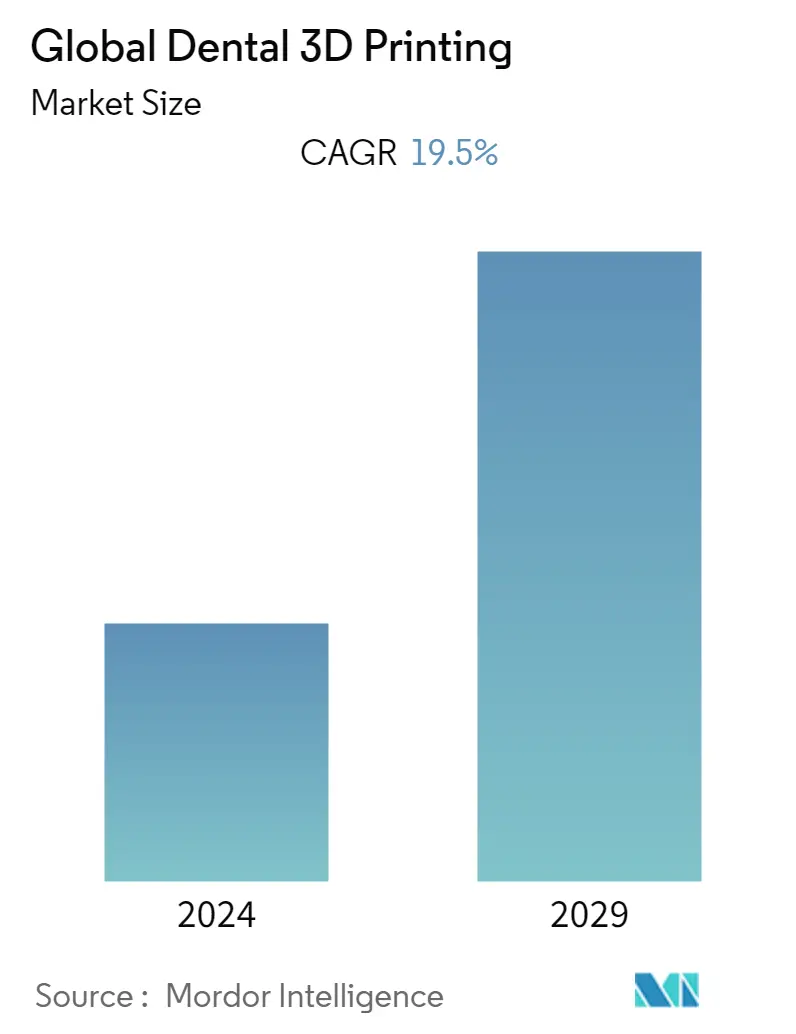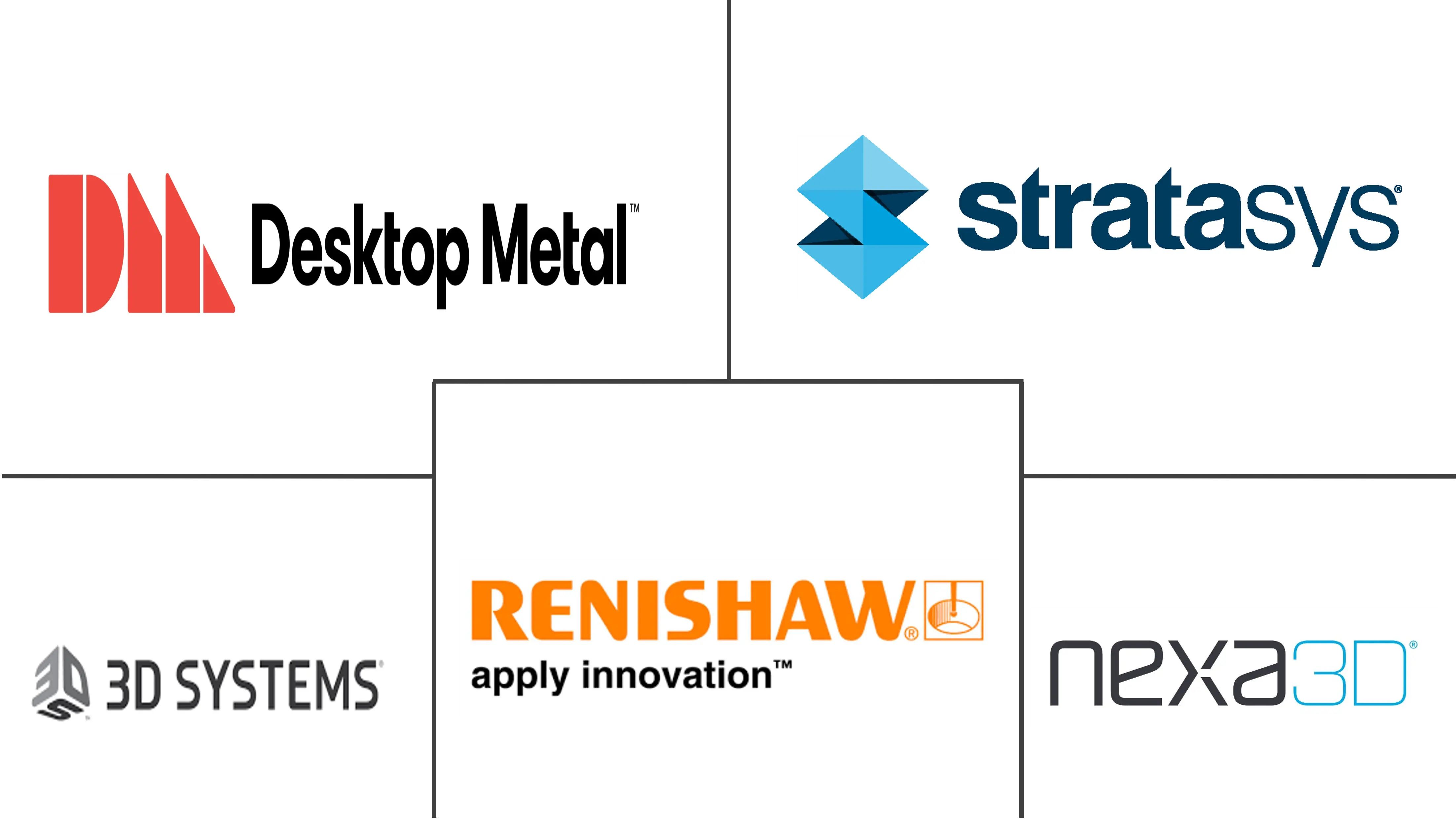Market Size of Global Dental 3D Printing

| Study Period | 2019 - 2029 |
| Base Year For Estimation | 2023 |
| CAGR | 19.50 % |
| Fastest Growing Market | Asia-Pacific |
| Largest Market | North America |
| Market Concentration | Medium |
Major Players
*Disclaimer: Major Players sorted in no particular order |
Dental 3D Printing Market Analysis
The dental 3D printing market is projected to register a CAGR of 19.5% during the forecast period (2022-2027).
The COVID-19 epidemic has wreaked havoc on a variety of industries, with dentistry being one of the hardest hit. The epidemic of coronavirus disease 2019 (COVID-19) essentially shut down around 198,000 active dentists and dental specialists in the United States, according to an essay published in August 2020 titled "COVID-19 and Dentistry: Challenges and Opportunities for Providing Safe Care." Moreover, the demand and sale of dental equipment and procedures were negatively impacted due to the global restrictions and lockdown in most countries. Furthermore, many device manufacturers shifted their focus to fight against coronavirus. For instance, in March 2020, 3D printer company Formlabs reported that it was using its more than 250 in-house 3D printers at its printing facility in Ohio to produce up to 150,000 COVID-19 test swabs per day. However, the medical device industry is trying to recover from the COVID-19 outbreak.
While the impact of COVID-19 continues to disrupt many sectors, the 3D-printing industry appears to have regained strength and is moving on a steady upward trajectory, according to a news article published in December 2021. Many factors in the dental industry have fueled this growth, including the need to streamline chairside appointments and improve safety for both dentists and patients. In the third quarter, 3D Systems, a leader in the dental industry for more than 30 years, saw double-digit growth compared to 2020 results. Healthcare revenue increased by 28.3% to USD 76.4 million, compared to the same period last year. When divestitures were taken into account, 3D Systems reported that high demand for dental applications, both printers, and materials, resulted in overall healthcare revenue increasing by 44.5% year over year.
Materialize is another company that is expanding. The Belgium-based company reported a 28.0% revenue increase in 2021 compared to 2020, with revenue for its medical segment up 10.2% and manufacturing up 62.0%, among several key areas of focus. Furthermore, Stratasys, a leading 3D-printing company for industries such as healthcare, consumer goods, and more, reported revenue growth of 24.3% and systems sales growth of 34.7% year over year. Revenue increased from USD 127.9 million in 2020 to USD 159.0 million in 2021, according to the company's third-quarter report. This was owing to contributions across all regions and all business lines.
In dentistry, technological advancements act as a catalyst for innovation and growth. This is especially true in digital dentistry. Although not everyone has embraced this technological evolution, most dental professionals would agree that going digital is the way to go. For starters, the advantages of 3D printing in dentistry are numerous. It allows dental professionals to stay current while also being more cost-effective than analog methods. There are frequent software updates, new dental materials launches, and rapidly evolving dental applications. For instance, in February 2022, Nobio announced the official launch of infinix, a new line of advanced antimicrobial restorative materials designed to fight recurrent decay. Also, in November 2019, Apex Dental Materials introduced RE-GEN, a suite of bioactive materials comprised of a Flowable Composite, Bulk Fill & Resin Cement, Pit & Fissure Sealant, and the world's first-ever Bioactive Universal and Self-Etch Adhesives.
Besides, 3D printing can significantly improve the workflow in any dental practice or laboratory and can drastically reduce patient chair time. It provides product customization flexibility as well as superior quality and accuracy in 3D-printed dental models. Dental professionals can now print occlusal splints and other dental models in-house in just one day, which was once unthinkable. This not only helps to generate revenue but also makes dental treatment easier. 3D printing materials are constantly evolving to provide users with a growing list of indications, and 3D printing can be easily integrated into any dental practice or laboratory's workflow.
The market is also driven by an increase in the number of dental caries and the need to treat them around the world. According to an article published in July 2019 titled "Oral Illnesses: A Global Public Health Concern," oral diseases are among the most common diseases worldwide, posing substantial health and economic burdens, and significantly lowering people's quality of life. Dental caries (tooth decay), periodontal disease, tooth loss, and malignancies of the lips and oral cavity are the most common and serious oral disorders worldwide. In addition, as per the World Health Organization (WHO), data updated in March 2020, estimates that oral disorders impact approximately 3.5 billion people globally, and severe periodontal (gum) disease, which can lead to tooth loss, is also highly common.
Hence, increasing dental caries, technological advancements, the launch of new products, and the benefits associated with the 3D printing technology are all factors that are projected to boost the market growth over the forecast period.
Dental 3D Printing Industry Segmentation
As per the scope of this report, three-dimensional (3D) printing technologies are advanced manufacturing technologies based on computer-aided design digital models to create personalized 3D objects automatically. Three-dimensional printing has a wide range of applications in dentistry, including prosthodontics, oral and maxillofacial surgery, and oral implantology, as well as orthodontics, endodontics, and periodontology. The report covers all aspects of 3D printing, from the materials used to the printers and scanners to create the final product. Furthermore, the scope includes services provided by market players to create customized products based on needs. The Dental 3D Printing Market is Segmented by Technology (Vat Photopolymerization, Polyjet Technology, Fused Deposition Modelling, Selective Laser Sintering, and Other Technologies), Product & Service (Materials (Plastic, Metal, Others), Equipment (Dental 3D Scanners, Dental 3D Printers), and Service), Application (Prosthodontics, Orthodontics, Implantology), End User (Dental Laboratories, Hospitals & Clinics, Others), and Geography (North America, Europe, Asia-Pacific, Middle-East and Africa, and South America). The market report also covers the estimated market sizes and trends for 17 different countries across major regions, globally. The report offers the value (in USD million) for the above segments.
| By Technology | |
| Vat Photopolymerization | |
| Polyjet Technology | |
| Fused Deposition Modelling | |
| Selective Laser Sintering | |
| Other Technologies |
| By Product & Service | |||||
| |||||
| |||||
| Services |
| By Application | |
| Prosthodontics | |
| Orthodontics | |
| Impantalogy |
| By End User | |
| Dental Laboratories | |
| Hospitals & Clinics | |
| Others |
| Geography | ||||||||
| ||||||||
| ||||||||
| ||||||||
| ||||||||
|
Global Dental 3D Printing Size Summary
The dental 3D printing market is experiencing significant growth, driven by technological advancements and the increasing demand for efficient and cost-effective dental solutions. The market is characterized by the integration of digital dentistry, which offers numerous benefits over traditional methods, such as improved workflow, reduced patient chair time, and enhanced customization and accuracy in dental models. The COVID-19 pandemic initially disrupted the industry, leading to a temporary decline in dental practices and a shift in focus towards producing medical supplies. However, the sector has shown resilience and is on a steady recovery path, with major players like 3D Systems and Stratasys reporting substantial revenue growth. The market is further propelled by the rising prevalence of dental caries, malocclusion, and the growing interest in cosmetic dentistry, which underscores the need for advanced dental treatments and technologies.
The North American region is poised to be a high-growth market due to its robust medical infrastructure, expanding elderly population, and the presence of key market competitors. The dental 3D printing market is highly competitive and fragmented, with several major players such as Formlabs, Nexa3D, and Renishaw plc. actively launching new products to maintain their market positions. Innovations like Dentsply Sirona's Primeprint 3D printer and Desktop Health's Einstein series highlight the ongoing advancements in the field. These developments are expected to drive market expansion, as they enable dental professionals to produce accurate models and guides with greater ease and efficiency. As the industry continues to evolve, the adoption of 3D printing technology in dental practices is anticipated to increase, offering new opportunities for growth and development in the market.
Global Dental 3D Printing Market Size - Table of Contents
-
1. MARKET DYNAMICS
-
1.1 Market Overview
-
1.2 Market Drivers
-
1.2.1 Increasing Incidence of Dental Caries and Other Dental Diseases
-
1.2.2 Rising Demand for Cosmetic Dentistry
-
1.2.3 Growing Adoption of Dental 3D Printers due to the Advantages it Offers
-
-
1.3 Market Restraints
-
1.3.1 High Cost of Electroceutical Devices
-
-
1.4 Porter's Five Forces Analysis
-
1.4.1 Threat of New Entrants
-
1.4.2 Bargaining Power of Buyers/Consumers
-
1.4.3 Bargaining Power of Suppliers
-
1.4.4 Threat of Substitute Products
-
1.4.5 Intensity of Competitive Rivalry
-
-
-
2. MARKET SEGMENTATION (Market Size by Value - USD million)
-
2.1 By Technology
-
2.1.1 Vat Photopolymerization
-
2.1.2 Polyjet Technology
-
2.1.3 Fused Deposition Modelling
-
2.1.4 Selective Laser Sintering
-
2.1.5 Other Technologies
-
-
2.2 By Product & Service
-
2.2.1 Materials
-
2.2.1.1 Plastic
-
2.2.1.2 Metal
-
2.2.1.3 Others
-
-
2.2.2 Equipment
-
2.2.2.1 Dental 3D Scanners
-
2.2.2.2 Dental 3D Printers
-
-
2.2.3 Services
-
-
2.3 By Application
-
2.3.1 Prosthodontics
-
2.3.2 Orthodontics
-
2.3.3 Impantalogy
-
-
2.4 By End User
-
2.4.1 Dental Laboratories
-
2.4.2 Hospitals & Clinics
-
2.4.3 Others
-
-
2.5 Geography
-
2.5.1 North America
-
2.5.1.1 United States
-
2.5.1.2 Canada
-
2.5.1.3 Mexico
-
-
2.5.2 Europe
-
2.5.2.1 Germany
-
2.5.2.2 United Kingdom
-
2.5.2.3 France
-
2.5.2.4 Italy
-
2.5.2.5 Spain
-
2.5.2.6 Rest of Europe
-
-
2.5.3 Asia-Pacific
-
2.5.3.1 China
-
2.5.3.2 Japan
-
2.5.3.3 India
-
2.5.3.4 Australia
-
2.5.3.5 South Korea
-
2.5.3.6 Rest of Asia-Pacific
-
-
2.5.4 Middle-East and Africa
-
2.5.4.1 GCC
-
2.5.4.2 South Africa
-
2.5.4.3 Rest of Middle-East and Africa
-
-
2.5.5 South America
-
2.5.5.1 Brazil
-
2.5.5.2 Argentina
-
2.5.5.3 Rest of South America
-
-
-
Global Dental 3D Printing Market Size FAQs
What is the current Global Dental 3D Printing Market size?
The Global Dental 3D Printing Market is projected to register a CAGR of 19.5% during the forecast period (2024-2029)
Who are the key players in Global Dental 3D Printing Market?
3D Systems, Inc., Stratasys, Nexa3D, Desktop Metal, Inc. and Renishaw plc. are the major companies operating in the Global Dental 3D Printing Market.

